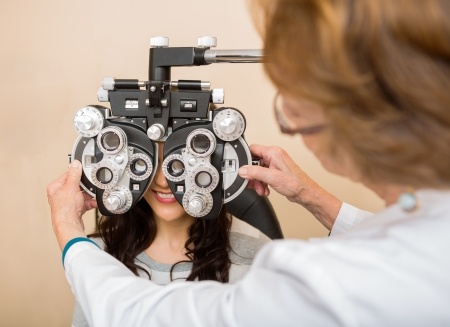How to Drive Safely with Low Vision
October 10, 2014 | Category: Automobile Accidents | Share Many driving-related injuries have been associated with visual problems. Contact lenses or glasses compensate for imperfect vision, up to a point, according to Rides In Sight.org which provides information to seniors on transportation options. Peripheral vision will often weaken as one ages. Reflection off wet streets can cause blurring, and halo effects from the headlights of oncoming vehicles may be more hazardous. Also, being able to distinguish shapes in a low-light situation can be a big problem.
Many driving-related injuries have been associated with visual problems. Contact lenses or glasses compensate for imperfect vision, up to a point, according to Rides In Sight.org which provides information to seniors on transportation options. Peripheral vision will often weaken as one ages. Reflection off wet streets can cause blurring, and halo effects from the headlights of oncoming vehicles may be more hazardous. Also, being able to distinguish shapes in a low-light situation can be a big problem.
Low vision, according to Dr. William Kayen of Low Vision Associates in New York City, is a condition in which a person has some vision but it is limited. This condition may interfere with daily pastimes such as reading, watching television, going on the computer and driving. People with low vision generally have some remaining vision with reduced sharpness, narrowed field of vision, haziness or blind areas. Dr. Kayen says the causes of low vision may often be the result of an injury, birth defect, the aging process, disease or a condition such as ocular albinism, retinitis pigmentosa or Stargardt's macular dystrophy. Should low vision occur later in life, it is usually caused by glaucoma, cataracts, macular degeneration or diabetes.
According to Low Vision Driving Instructors by practicing adaptive behavior, low vision drivers can be safe drivers.
AARP (American Association of Retired Persons) has the following "Vision Tips" for drivers:
In general:
- Have regular eye examinations by a licensed ophthalmologist or optometrist.
- Ask if you should get separate glasses for day and night driving.
- Ask about anti-reflective coatings to reduce glare and improve night vision.
- Do not use eyeglass frames with wide, heavy temples, (side pieces); they may restrict side vision.
- Reduce driving at night, dusk or dawn when visibility is more difficult.
- Use caution driving in rain and/or fog.
Before driving:
- Make sure the windshield and windows (inside and out), headlights and tail lights are clean at all times.
- Wear clean corrective lenses or contacts with an up-to-date prescription.
- Make sure mirrors are properly adjusted.
- Have a mechanic check to see if the headlights are properly adjusted so they light the road properly, and they do not cause glare for other drivers.
While driving:
- Watch for parked vehicles, cyclists, pedestrians, children and animals, especially those in the driver's side vision.
- Use extra caution when turning left and trying to judge the speed/distance of oncoming vehicles.
- Choose roads that are well-lit; avoid poorly lit areas.
- Have a good pair of sunglasses handy for daytime glare situations.
- Do not wear sunglasses or dark or tinted glasses at night, dusk, or dawn unless prescribed by an eye doctor.
- Drive more slowly at night and avoid looking directly into headlights of approaching vehicles; look slightly to the right.
Port Charlotte Vehicle Accident Attorney, Randall L. Spivey is a Board Certified Trial Attorney – the highest recognition for competence bestowed by the Florida Bar and a distinction earned by just one (1%) percent of Florida attorneys. He has handled over 2,000 personal injury and wrongful death cases throughout Florida. For a free and confidential consultation to discuss your legal rights, contact the Spivey Law Firm, Personal Injury Attorneys, P.A., in Lee County at 239.337.7483 or toll free at 1.888.477.4839,or by email to Randall@SpiveyLaw.com. Visit SpiveyLaw.com for more information. You can contact Spivey Law Firm, Personal Injury Attorneys, P.A.in Charlotte County at 941.764.7748 and in Collier County 239.793.7748.

